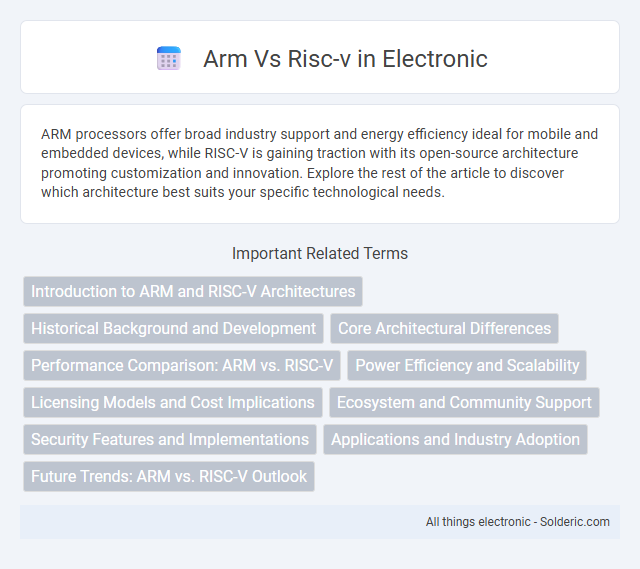ARM processors offer broad industry support and energy efficiency ideal for mobile and embedded devices, while RISC-V is gaining traction with its open-source architecture promoting customization and innovation. Explore the rest of the article to discover which architecture best suits your specific technological needs.
Comparison Table
| Feature | ARM | RISC-V |
|---|---|---|
| Architecture Type | Proprietary RISC | Open-Source RISC |
| Instruction Set | Fixed, licensed ISA | Modular, extensible ISA |
| Licensing | Closed, requires license fees | Free, open standard |
| Ecosystem | Mature, broad software and hardware support | Growing, increasing adoption |
| Performance | Highly optimized for mobile & embedded | Competitive, customizable cores |
| Security Features | TrustZone, extensive security extensions | Security extensions evolving, customizable |
| Market Usage | Smartphones, IoT, embedded systems | Emerging in academia, IoT, embedded |
| Development Support | Robust tools, wide industry backing | Open tools, growing community support |
| Power Efficiency | Proven low-power designs | Potential for efficient custom cores |
Introduction to ARM and RISC-V Architectures
ARM architecture, developed by ARM Holdings, is a widely adopted, proprietary instruction set architecture (ISA) known for its power efficiency and extensive ecosystem in mobile and embedded devices. RISC-V is an open-source ISA designed for flexibility and customization, enabling developers to modify and extend the architecture without licensing fees or restrictions. Your choice between ARM and RISC-V will depend on factors such as licensing costs, ecosystem maturity, and specific application requirements.
Historical Background and Development
ARM architecture, developed in the 1980s by Acorn Computers, revolutionized low-power computing with its Reduced Instruction Set Computing (RISC) design, becoming dominant in mobile and embedded systems. RISC-V emerged in 2010 from the University of California, Berkeley, as an open-source instruction set architecture (ISA) aiming to provide a flexible and extensible alternative to proprietary designs like ARM. Your choice between ARM and RISC-V may depend on the need for established ecosystem support versus customization potential inherent in RISC-V's open development model.
Core Architectural Differences
ARM cores utilize a Complex Instruction Set Computing (CISC) architecture with a rich set of instructions optimized for performance and energy efficiency, while RISC-V employs a Reduced Instruction Set Computing (RISC) design emphasizing simplicity and modularity. RISC-V's open-source ISA allows customization and extension, enabling tailored solutions that can drive innovation and cost-effective implementations. Your choice between ARM and RISC-V depends on whether you prioritize established ecosystem support or the flexibility of an open architecture.
Performance Comparison: ARM vs. RISC-V
ARM processors exhibit mature and highly optimized performance across a wide range of applications due to extensive industry adoption and advanced microarchitectural designs. RISC-V architectures, gaining momentum with customizable and open-source instruction sets, offer scalable performance benefits particularly in embedded systems and specialized computing. Benchmark tests demonstrate ARM's edge in high-performance, power-efficient cores while RISC-V excels in flexibility and innovation for tailored workloads.
Power Efficiency and Scalability
RISC-V architecture offers high power efficiency due to its simple, modular design, enabling You to optimize power consumption in embedded and IoT devices more effectively than traditional ARM cores. ARM processors provide proven scalability with extensive ecosystem support, delivering robust performance across mobile, automotive, and data center applications while maintaining efficient energy use. Choosing between ARM and RISC-V depends on Your specific power and scalability requirements, balancing ARM's mature infrastructure with RISC-V's growing adaptability.
Licensing Models and Cost Implications
ARM operates under a proprietary licensing model, requiring companies to pay upfront fees and ongoing royalties for using its architecture, which can increase overall development costs. RISC-V employs an open-source ISA model that eliminates licensing fees, allowing businesses to reduce expenses and enable more flexible customization. The cost implications favor RISC-V for low-cost and high-volume products, while ARM's established ecosystem may justify its licensing costs for certain commercial applications.
Ecosystem and Community Support
ARM benefits from a vast, well-established ecosystem featuring extensive tooling, software libraries, and widespread industry adoption that supports rapid development and deployment across diverse applications. RISC-V, while newer, experiences exponential growth in open-source community contributions and flexible customization options, attracting academic research and startups focused on innovation and cost-effective solutions. The ARM ecosystem excels in mature commercial support, whereas RISC-V's expanding ecosystem fosters transparency and collaborative growth, driving competitive momentum in processor design.
Security Features and Implementations
ARM processors incorporate extensive security features such as TrustZone technology, which creates secure and non-secure worlds to safeguard sensitive code and data. RISC-V security implementations emphasize customizable security modules, including physical memory protection (PMP) and cryptographic extensions that allow your system to tailor defenses based on specific needs. Both architectures support hardware-enforced isolation and secure boot mechanisms, but ARM's mature ecosystem offers more integrated security solutions, while RISC-V provides flexibility for innovative, open-source security designs.
Applications and Industry Adoption
ARM architecture dominates mobile devices, embedded systems, and IoT applications due to its energy efficiency and extensive developer ecosystem. RISC-V gains traction in academic research, custom ASICs, and emerging AI hardware, offering open-source flexibility and customization advantages. Your choice depends on industry needs: ARM suits established markets, while RISC-V appeals to innovation-focused sectors seeking adaptable solutions.
Future Trends: ARM vs. RISC-V Outlook
RISC-V's open-source architecture drives rapid innovation and customization, attracting significant investment and fostering ecosystem growth. ARM maintains dominance with energy-efficient designs and extensive software support critical for mobile and embedded markets. Future trends indicate RISC-V's expanding adoption in AI, IoT, and edge computing, while ARM advances with enhanced security features and heterogeneous computing integration.
arm vs risc-v Infographic

 solderic.com
solderic.com